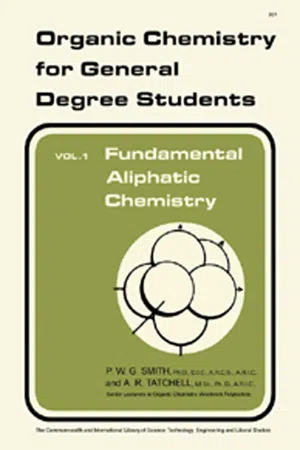
Fundamental Aliphatic Chemistry
Organic Chemistry for General Degree Students
- 300 pages
- English
- ePUB (mobile friendly)
- Available on iOS & Android
Fundamental Aliphatic Chemistry
Organic Chemistry for General Degree Students
About This Book
Organic Chemistry for General Degree Students is written to meet the requirements of the London General Internal examination and degree examinations of a similar standing. It will also provide for the needs of students taking the Part 1 examination for Graduate Membership of the Royal Institute of Chemistry, or the Higher National Certificate, whilst the treatment is such that Ordinary National Certificate courses can be based on the first two volumes
Within the limits broadly defined by the syllabus, the aim of this first volume is to provide a concise summary of the important general methods of preparation and properties of the main classes of aliphatic compounds. Due attention is paid to practical considerations with particular reference to important industrial processes. At the same time, the fundamental theoretical principles of organic chemistry are illustrated by the discussion of a selection of the more important reaction mechanisms. Questions and problems are included, designed to test the student's appreciation of the subject and his ability to apply the principles embodied therein. A selection of questions set in the relevant examinations is also included.
Frequently asked questions
Information
Introduction
Publisher Summary
Qualitative Analysis

Quantitative Analysis
Table of contents
- Cover image
- Title page
- Table of Contents
- Copyright
- Preface
- Chapter 1: Introduction
- Chapter 2: Atomic Structure and Chemical Bonding
- Chapter 3: The Paraffins
- Chapter 4: Halogen Derivatives of Aliphatic Hydrocarbons
- Chapter 5: Aliphatic Alcohols and Ethers
- Chapter 6: The Structure of Multiple Bonds
- Chapter 7: The Olefins
- Chapter 8: Acetylenes and Diolefins
- Chapter 9: Aliphatic Aldehydes and Ketones
- Chapter 10: Aliphatic Monocarboxylic Acids and their Derivatives
- Chapter 11: The Synthetic Uses of Grignard Reagents, β-Keto Esters and Diethyl Malonate
- Chapter 12: Introduction to Stereoisomerism
- Chapter 13: Aliphatic Nitro Compounds and Amines
- Chapter 14: Aliphatic Sulphur-containing Compounds
- Questions
- Answers to Problems
- Index